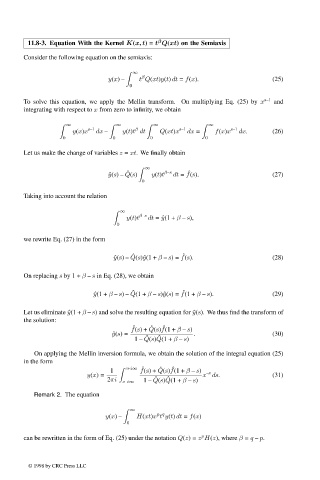Page 566 - Handbook Of Integral Equations
P. 566
β
11.8-3. Equation With the Kernel K(x, t)= t Q(xt) on the Semiaxis
Consider the following equation on the semiaxis:
∞
β
y(x) – t Q(xt)y(t) dt = f(x). (25)
0
To solve this equation, we apply the Mellin transform. On multiplying Eq. (25) by x s–1 and
integrating with respect to x from zero to infinity, we obtain
∞ ∞ ∞ ∞
β
y(x)x s–1 dx – y(t)t dt Q(xt)x s–1 dx = f(x)x s–1 dx. (26)
0 0 0 0
Let us make the change of variables z = xt.We finally obtain
∞
ˆ
ˆ
ˆ y(s) – Q(s) y(t)t β–s dt = f(s). (27)
0
Taking into account the relation
∞
y(t)t β–s dt = ˆy(1 + β – s),
0
we rewrite Eq. (27) in the form
ˆ
ˆ
ˆ y(s) – Q(s) ˆy(1 + β – s)= f(s). (28)
On replacing s by 1 + β – s in Eq. (28), we obtain
ˆ
ˆ
ˆ y(1 + β – s) – Q(1 + β – s) ˆy(s)= f(1 + β – s). (29)
Let us eliminate ˆy(1 + β – s) and solve the resulting equation for ˆy(s). We thus find the transform of
the solution:
ˆ
ˆ
ˆ
f(s)+ Q(s)f(1 + β – s)
ˆ y(s)= . (30)
ˆ
ˆ
1 – Q(s)Q(1 + β – s)
On applying the Mellin inversion formula, we obtain the solution of the integral equation (25)
in the form
f(s)+ Q(s)f(1 + β – s)
1 c+i∞ ˆ ˆ ˆ –s
y(x)= x ds. (31)
ˆ
ˆ
2πi 1 – Q(s)Q(1 + β – s)
c–i∞
Remark 2. The equation
∞
p q
y(x) – H(xt)x t y(t) dt = f(x)
0
p
can be rewritten in the form of Eq. (25) under the notation Q(z)= z H(z), where β = q – p.
© 1998 by CRC Press LLC
© 1998 by CRC Press LLC
Page 549

